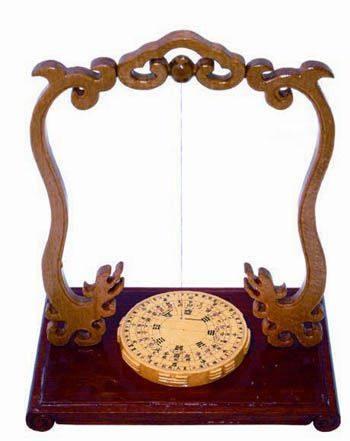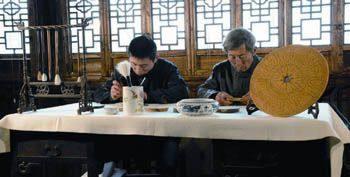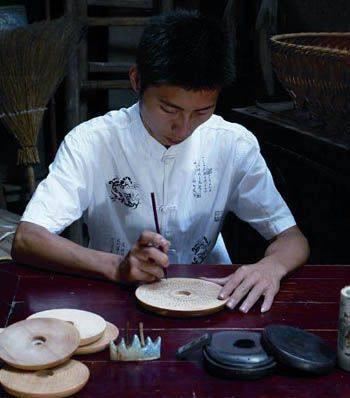Wu Shuisen – The Compass Master
SUN ANJIAN


THE humble compass is among the most widely used of all tools today. Whether it be simple navigation, GPS, aviation, military duties or an iPhone app, the compass seems to pop up everywhere. In ancient China, the compass nevertheless had one function that is seldom used today – that of a “magical key” to determine the ideal location for a house in accordance with fengshui principles.
While the compass nowadays has been subsumed into an array of other devices, Wu Shuisen and his family, living in Wanan in Anhui Provinces Xiuning County, carry on the proud tradition of making compasses in traditional Chinese fashion.
Wus ancestor Wu Luheng (1702-1760) mastered the skills required for making compasses at a young age and opened a shop in Wanan in 1723. Almost two centuries later, his craftsmanship was recognized at the Panama Pacific International Expo when his 5th and 6th-generation decedents won a gold medal for their work at the event. Seven generations on from Wu Luhengs pioneering work, Wu Shuisen has taken up his mantle and is dedicated to elevating compass making to new heights in China.
Wu Shuisen was born in 1949. His father passed away when he was just 12 years old and was thus unable to pass on to his son all the necessary skills to make beautiful compasses. According to Wu family traditions, compass-making techniques are passed down to male family members, as well as their wives. Having assisted her husband for years, Wu Shuisens mother had developed an intimate understanding of the compass-making process. She went on to help local people repair their compasses following her husbands untimely death. After coming home from school, Wu Shuisen would assist his mother. Tinkering in the family workshop after school and on weekends, Wu slowly advanced along the road to becoming a compass master in his own right.
In the late 1980s, Wu Shuisen reopened the familys compass store and truly became heir to Wu Luhengs great tradition.
Chinese compasses, like most other designs, consist of a magnetic needle and a plate. Unique to the Chinese design, the compass plate around the needle is marked with Chinese characters that are set in several concentric circles in accordance with the laws of yin and yang. The compass is also divided into a heaven plate and an earth plate, indicating Chinese hemispherical dome cosmology.
The compass that Wu Shuisen specializes in was historically called the Hui Compass. Among the items his father left for him were a good number of documents that recorded the entire process of making the Hui Compass, as well as an atlas detailing various other compass designs.
The Wu family compass shop has experienced good times and bad, but is now prospering under Wu Shuisens stewardship. He follows to the letter the traditional way of making Hui Compasses, and also produces a number of other products, such as Sanhe Compasses, Sanyuan Compasses as well as different kinds of sundials, moondials and fengshui rulers.
Wu says he was keen to bring back to life a number of other great compass traditions. “I had always dreamed of remaking the suspended compasses that were recorded by the famous Northern Song scientist Shen Kuo (1031-1095). They ceased to be produced over 400 years ago in the Ming Dynasty.” Having researched and experimented for five years, Wu managed to reproduce the suspended compass in 2005. Scientific tests subsequently proved that there is not much difference between suspended compasses and marine compasses in terms of accuracy.
Wus family makes compasses according to an unvarying process. First, they select ginkgo trees at least 30 years old as the raw material – this timber is strong but pliable, and makes for a fine surface. The wood is cut into different sizes according to need and smoothed down. The main piece of ginkgo is shaped into a disk. A hole pierced in its center holds the magnetic needle.
Next, craftsmen carve a number of divisions on the wooden disk according to the prescriptions of Wus atlas. Carved circles emanate out from radius to form horizontal divisions. Vertical divisions are determined by the “Eight Diagrams” of Taoist cosmology as well as the 10 “Heavenly Stems” and 12 “Earthly Branches” –the traditional way of numbering time in China. The divisions are then colored with ink and polished with fine sand paper and equisetum, commonly known as snake grass.
Next is perhaps the most intricate part of the production process. Using a calligraphy brush pen, craftsmen adorn each division with minute Chinese characters to show different directions as per the rules of fengshui. One slip of the brush and the disk is ruined.
Before the magnetic needle is installed, the plate is coated with several layers of Tung oil, refined according to a secret process. A well-coated compass maintains its efficacy for hundreds of years
Before his compasses hit the shelves, Wu Shuisen personally magnetizes the needles on a natural stone meteorite according to generations of tradition, making the needles highly magnetized and extremely sensitive. The shop owner determines the center of gravity of the needle before installing it into the hole and ensures through elaborate testing that the needle is not influenced by any resistance and able to rotate freely.
After the needle is in place, the center of the device is covered with a thin piece of glass. Finally, the compass is packed and goes to market.
Today, a large range of compasses jostle for space in Wus shop. They are incorporated with various traditional artistic elements such as circular engravures, relief sculptures, hollowed-out carvings, calligraphy, traditional Chinese paintings and others. Compasses come not only in spheres, but also in the shape of tortoises, lotuses, bells and dragons.
The Chinese government has recently been placing greater emphasis on preserving traditional culture. After the Law on Intangible Cultural Heritage was adopted on July 21, 2011, the Ministry of Culture launched a series of measures to protect and sponsor the inheritors of Chinas intangible cultural heritage.
In 2009, Wu Shuisen was approved by the Ministry of Culture as one such inheritor of national intangible cultural heritage. His son Wu Zhaoguang is also learning the skills that will make him eighth in the line of Wu compass masters.
In todays society, traditional compasses are more than just appliances to help in the application of fengshui. The compass has become a form of art in its own right popular among lay people and connoisseurs alike. Rising demand for his products is actually posing challenges for Wu as he is forced to decide whether or not to pursue success in the thriving market by replacing traditional craftsmanship with modern manufacturing methods. Moreover, the gingko trees that provide the essential raw material for production are now a protected species and can no longer be felled at random.
In an increasingly digitized world, Wu Shuisen and his son worry that the art of traditional compass making may eventually be lost to history. For them, ensuring compasses are beautiful and have an artistic aesthetic is one way of guaranteeing their future.



